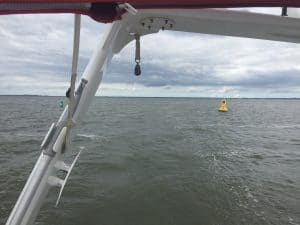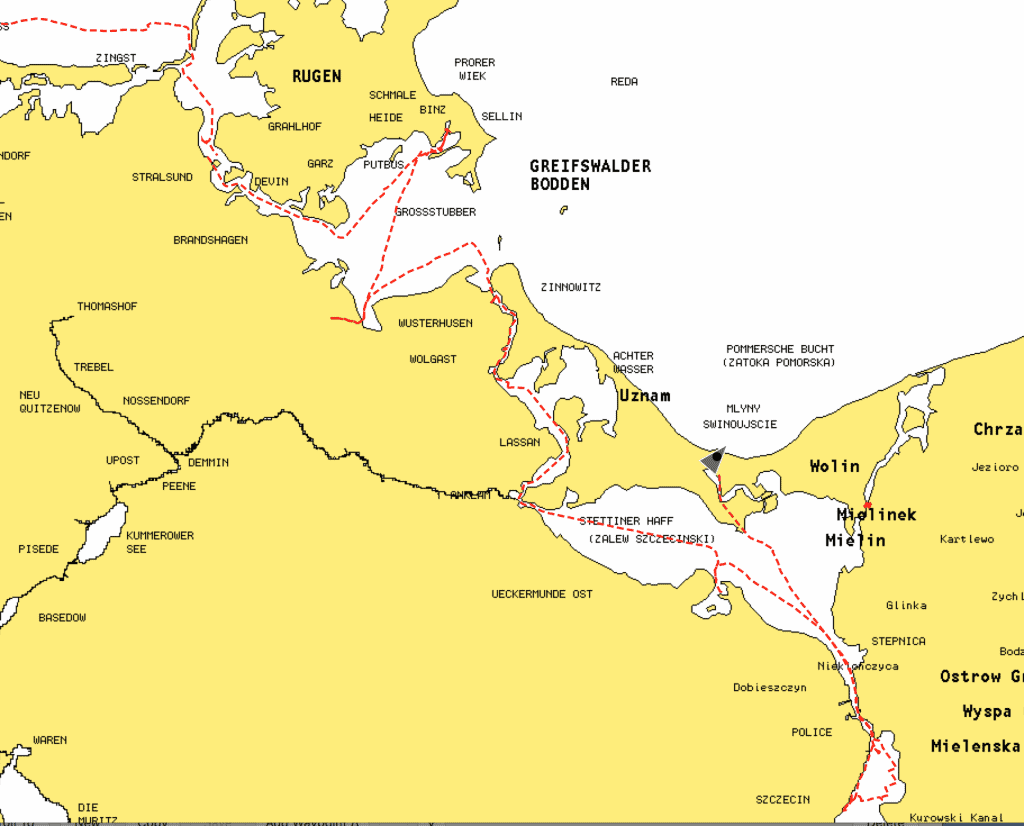We left Gröslin on 9th July. We had a good sail through the Peenestrom – the narrow channel separating the island of Usedom from the mainland. There were two lifting bridges to pass, which only open a few times a day, so we spent a night anchored in a large lake, the Achterwasser, between them. Despite the narrow dredged channels across the shallows, we managed to sail almost all the way. We passed the second bridge at Wolgast in the company of around ten other yachts, all sailing under just genoas, and, with our feathering propellor installed again, were able to keep at the front once again.
From here we entered the Stettiner Haaf – a large inland sea some 26nm long and about 10nm wide. The German-Polish boarder runs through this. These days, with both countries being part of the Schengen area, there is no longer a need for customs launches to check boats crossing – occasional yellow border buoys are all that marks the line. We turned into the channel leading into the Neuwarper See, which is also part of the boarder and anchored for the night. Our anchor was in Germany and the boat in Poland! This raised the issue of which courtesy flag should be flown. To fly both with one higher than the other would be a severe breach of flag etiquette, so we settled for one on each side of the cross trees. The next morning we made the short trip into the harbour at Nowe Warpno on the Polish side. It is an attractive village and has been well restored. It also has a cash machine so we could draw Polish Zloties – for Poland is not in the Eurozone.
From here we sailed further south east and into the River Oder. This is a very attractive river with reedy margins and a complex of channels and islands between its two branches the East and West Oder. It runs far inland and gives access via a canal to Berlin, although not for yachts with their masts up. We sailed into the Jezioro Dḁbie, a large side lake, and tacked down to its southern end to anchor overnight before entering the city of Szczecin.
To understand anything of this area you need to be aware of its history. UK readers have the luxury of the British Isles with their natural well-defined boundaries. In continental Europe boundaries have frequently changed through war, treaties or even marriage settlements. From here it is easy to see how important the institution of the EU is to contain nationalism. In 1945 the whole of Poland was moved westwards by some 150 miles, following the land grab by Stalin’s Soviet Union. All the areas in northern Poland we will be visiting were part of Germany before that time and Szczecin was the German city of Stettin. Its principle buildings are vast, reflecting the imperial grandeur of German Pomerania . During WWII its docks and central areas were very heavily bombed and the city mostly flattened. It has gradually been rebuilt although little remains of its great Hanseatic past. Today it is a big industrial port and city with a web of flyover junctions and roaring traffic. Further out it is modelled on Paris with a central circus, radiating avenues and lovely leafy parks which we enjoyed.
- Grand Szczecin buildings
After the busy city we retreated back to the Jezioro Dḁbie where we anchored for three nights to rest, do maintenance work on the boat and await suitable winds for our next stretches.
On Friday we sailed out of the Oder, across the Stettiner Haaf in strong winds and along a canal through the northern landmass to reach the port of Swinoujscie. [UK readers: pronounced something like Sfeen-o-weesh-chey.] From here we can emerge back into the Baltic Sea, having been ‘inside’ in various lakes and channels for sixteen days. [See chart below.] The Polish ports along the Baltic coast are dangerous to enter in strong winds, but we need enough wind to reach the next port, so we will be carefully choosing our moments to move between them.
That’s for now
Tony & Ynskje





